Mesothelioma Survival Rates
About 40 percent of patients with mesothelioma survive the first year after diagnosis. That survival rate depends on many factors, including age, cancer stage, cancer type, race and gender. Long-term survivors attribute their success to treatment from a mesothelioma specialist, alternative medicine and nutritional changes.
ow is survival rate measured?
ow is survival rate measured?
Researchers describe the mesothelioma survival rate in several ways. They usually talk about it in terms of one-year survival, the percentage of people who survive for a year after diagnosis. Through their studies, they also look at longer survival times, including the number of people who live two years, three years and five years.
Average mesothelioma survival rates
Mesothelioma claimed nearly 30,000 American lives between 1999 and 2010. About 40 percent of U.S. patients live to the one year mark. By the second year, about 20 percent of patients are still alive. And by the third year, the number is 8 percent.
Gender
Research shows that women with pleural mesothelioma experience nearly three-fold better survival rate compared to men. After analyzing more than 14,000 pleural mesothelioma cases reported in the National Cancer Institute’s SEER database from 1973 to 2009, researchers found that the overall five-year survival rate for men was 4.5 percent, compared with 13.4 percent for women.
Mesothelioma Survival Rates by Gender
Most asbestos exposure occurs in the workplace, particularly in industrial jobs traditionally held by men. That helps explain why men account for around 80 percent of all mesothelioma cases.
When asbestos use was far more pervasive decades ago, the few women who did develop a related illness were usually exposed because they lived near mines or factories – especially those that processed the mineral. Women also found themselves exposed by spouses, family members or friends who worked around asbestos brought home the tiny fibers on their clothes.
Although numerous factors contribute to patient survival, women with mesothelioma appear to survive longer than men regardless of age, cancer stage, race or type of treatment. For every age group studied in the National Cancer Institute's Surveillance, Epidemiology and End Results (SEER) program, women fared significantly better than men. There is currently no conclusive answer as to why, but some researchers believe the improved survival could be explained by hormonal differences between genders.
Beating the Odds: Jacob H.
Jacob, 60, went back to work quickly, and is still going strong four years after cytoreductive surgery and HIPEC at the University of Maryland's Greenebaum Cancer Center.
See Jacob's StoryRace
Mesothelioma is almost exclusive to white individuals, who make up 95 percent of patients. This vast difference may be in large part because black and Hispanic individuals are less likely to be diagnosed with any type of cancer, mesothelioma included. Data from SEER state that African-Americans and Hispanics account for only 8 percent of all cancer diagnoses.
Mesothelioma Survival Rates by Race
Regardless of race, about 40 percent of mesothelioma patients survive one year. Two years from diagnosis, approximately 20 percent of patients survive. Although race does not appear to impact mesothelioma survival rate initially, as time goes on race becomes a more telling factor. From three years on, the survival rate of white patients is slightly worse than other ethnicities.
Five-year survival among whites is 7.6 percent, compared with 12.3 percent for blacks. After 10 years, only 4.2 percent of white patients survive, while 9.5 percent of blacks are alive after the same amount of time. SEER data used to calculate these survival rates includes Hispanics among patients who identify as both black and white. Because mesothelioma is so rare among other races, reliable survival statistics are not available.
Survival rates by ethnicity may be influenced by treatment decisions. One 2010 report that studied mesothelioma rates from 1990 to 2004 concluded that although black and Hispanic patients have better long-term survival, they are less likely to undergo surgery. While 25 percent of white patients received surgery during this time, among black patients the rate was 14 percent.
Beating the Odds: John Conway
John Conway is a 19-year Navy Veteran diagnosed with pleural mesothelioma in 2012. After nine rounds of chemotherapy he is now ready to get back out and do what he loves, deep sea fishing.
See John's StoryCancer Site
There are four types of mesothelioma, and the site where the cancer originates can greatly affect patient survival. Of the two most common mesothelioma types, pleural and peritoneal, survival is significantly better for peritoneal mesothelioma patients. This, however, has not always been the case.
Mesothelioma Survival Rates by Site
Before the emergence of an advanced peritoneal mesothelioma therapy called HIPEC that combines cytoreductive surgery and heated chemotherapy, median survival for untreated patients was about 6 months. This compares to a median survival of less than 12 months for patients with untreated pleural mesothelioma. In select studies, heated chemotherapy has boosted peritoneal mesothelioma survival to between 40 and 92 months.
The remaining two types, pericardial and testicular mesothelioma, combined account for less than 2 percent of all asbestos-related cancer cases. Median survival for testicular mesothelioma, the rarest type, is 24 months. About 40 percent of patients die from the disease. Pericardial mesothelioma has a median survival ranging from six to 10 months.
Although you have no control over the location of your cancer, you may be able to prolong survival by investigating all treatment options available to you. People diagnosed at an early stage can greatly benefit from a treatment plan involving aggressive surgery.
People with advanced cancer are unlikely to qualify for surgery, but may improve survival and quality of life by participating in clinical trials exploring the latest experimental treatment options. Be sure to ask your doctor about potential treatment options and how they may affect your outlook.
Beating the Odds: Tim C.
Tim is a pleural mesothelioma survivor in Georgia who first was diagnosed more than 10 years ago at age 45. He was young enough and strong enough to withstand an extrapleural pneumonectomy (EPP), which removed one of his lungs, and the subsequent chemotherapy and radiation.
Read Tim's StoryState and Region
Mesothelioma predominantly affects groups living in more industrial states or those with naturally occurring asbestos deposits. While survival rates by state are not significant, death rates can be used to describe the total number of deaths in each state. This figure is usually expressed in deaths per million, meaning the number of deaths for every million residents of the state.
Mesothelioma Death Rates by State, 1999-2010
The basic formula is this:
Death Rate (in deaths per million) = (Mesothelioma Deaths / Total Population) * 1,000,000
If the total number of residents in a state is 2 million, for example, and a total of 10 people died of mesothelioma, the death rate is 5 deaths per million. This formula provides a way for researchers to account for vast population differences between states. In more populous states, there may be a high number of mesothelioma deaths but a comparatively low death rate.
In addition to correcting for population differences between states, researchers may also adjust statistics for age differences. Because mesothelioma is most often diagnosed in people between 50 and 70 years old, states with older populations appear to have higher mesothelioma death rates, even when this may not be true.
For more meaningful comparisons across states and other regions, researchers can calculate age-adjusted death rates. When researchers do not age-adjust data, such as in the death rate formula above, the results are known as the crude death rate. Based on data from 1999 to 2010, Maine has the highest age-adjusted death rate of 14.6 deaths per million people. Besides Maine, 26 other states had a higher mesothelioma death rate than the national average of 8.3 deaths per million.
The top five states by age-adjusted death rates include:
- Maine — 14.6 deaths per million
- Alaska — 13.6 deaths per million
- Washington — 13.1 deaths per million
- Wyoming — 12.0 deaths per million
- New Jersey — 11.5 deaths per million
Stage of Cancer
The stage of your cancer at diagnosis is a strong predictor of overall survival. Survival is best among people diagnosed with mesothelioma at an early stage, before cancer spread starts to limit treatment options.
Early-stage patients who receive prompt treatment experience improved survival because they are more likely to qualify for surgery and other aggressive treatments associated with better outcomes.
Pleural Mesothelioma Median Survival Rate by Stage
Normally, mesothelioma is not diagnosed until it reaches stage III or stage IV, the last stages of development. This can include a larger tumor or extensive cancer spread throughout the body. Later stages of mesothelioma are more difficult to treat effectively, so these patients have worse survival rates.
A late diagnosis is common because it can take 20 to 50 years after asbestos exposure for mesothelioma to develop, and many people don't experience symptoms until the cancer has already reached an advanced stage.
While there is no established staging system for peritoneal mesothelioma, some researchers have proposed their own systems based on the TNM system, which uses tumor size, lymph node involvement and cancer spread to describe the extent of many types of cancer.
One such novel staging system has three stages based on TNM characteristics and a measure of tumor burden called the peritoneal cancer index (PCI). In a 2011 international study involving 294 peritoneal mesothelioma patients treated with cytoreductive surgery and heated chemotherapy, researchers used this system to describe patient survival.
One-year survival for stage I patients was 94 percent, 87 percent for stage II and 66 percent for stage III. The researchers also calculated five-year survival, which was 87 percent for stage I, 53 percent for stage II and 29 percent for stage III.
Beating the Odds: Andy A.
Andy survived a 70 mph motorcycle crash in 2004 and beat the odds again surviving for the past three years with stage IV mesothelioma. He credits his survival with the immunotherapy drug Amatuximab (MORab-009), which is currently being tested in clinical trials.
See Andy's StoryTumor Histology
The histology, or cellular makeup, of a mesothelioma tumor is also an accurate predictor for patient survival. Mesothelioma has three primary cell types: Epithelial, sarcomatoid and biphasic. They differ not only in appearance, but also in behavior.
Median Survival Rate by Tumor Histology
With a median survival of 12 to 24 months, epithelial mesothelioma has the best prognosis. This cell type is the least aggressive and responds best to treatment. Sarcomatoid mesothelioma, on the other hand, has a median survival of six months. Sarcomatoid tumors exhibit more aggressive behavior in terms of cell growth and invasive spread. Biphasic mesothelioma, which has both epithelial and sarcomatoid features, has a median survival of 12 months.
In a large, multi-institutional study that investigated how tumor histology and other factors affect survival, researchers observed similar survival rates. Among more than 3,000 pleural mesothelioma patients, epithelial cell type had the best survival rate, with a median survival of 19 months. Sarcomatoid patients experienced a median survival of eight months, the worst outcome of all cell types. Median survival for biphasic patients was 13 months.
Factors That Affect Survival Rate
Many patients want to know if mesothelioma is curable, but survival rates for mesothelioma cancer vary by the patient's age, gender, race and several other factors. The location, stage and cell type of the cancer, as well as your overall health, have the strongest influence on your prognosis.
Below is a breakdown of some common factors and how each correlates to a patient's survival rate:
Age
Overall, older mesothelioma patients have a much lower survival rate than younger ones. More than 50 percent of patients diagnosed before the age of 50 live one year, but less than 33 percent of patients 75 or older live the same amount of time. Rates are similar for long-term survival. Younger patients have a 20 percent chance of surviving a decade; older individuals have a 1 percent chance.
Mesothelioma Deaths by Age Range: 1999-2005
This difference is largely because younger patients are eligible for more intensive treatments like surgery. Older individuals may not be candidates for these procedures because of poor overall health or a high risk of complications.
Elderly people often manage one or more chronic medical conditions in addition to mesothelioma, such as diabetes, heart disease and COPD. Survival is generally better for younger people because they are less likely to have serious conditions that may make them ineligible for effective treatment options.
It's rare when someone younger than 50 receives a diagnosis of asbestos-related cancer. The average age at diagnosis is 60, and from 1999 to 2010, nearly 80 percent of Americans who died from mesothelioma were older than 65.
Mesothelioma Survival Rates by Age
When researchers break down survival rates by age, it's easy to see that the long-term outlook is best for patients diagnosed at a young age. National Cancer institute data show that while 43 percent of patients younger than 45 survive five years after diagnosis, that drops sharply — to 14.3 percent — for patients between the ages of 45 and 54. Overall, 5.7 percent of patients ages 65 and older at diagnosis survive after five years.




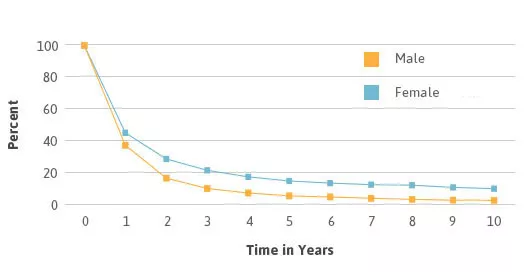

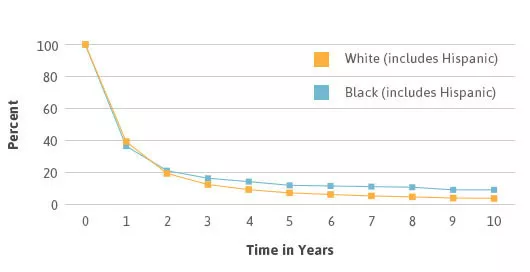

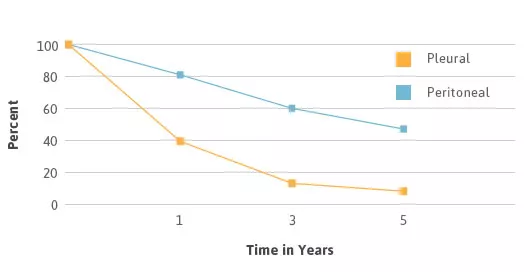

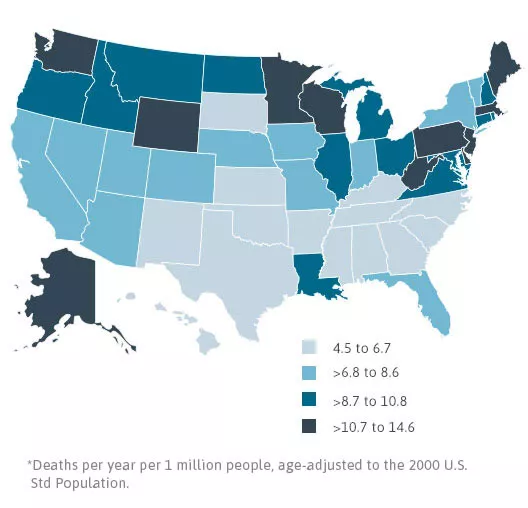
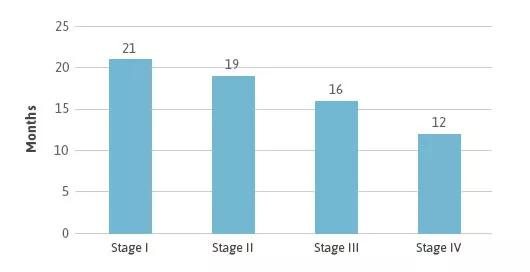

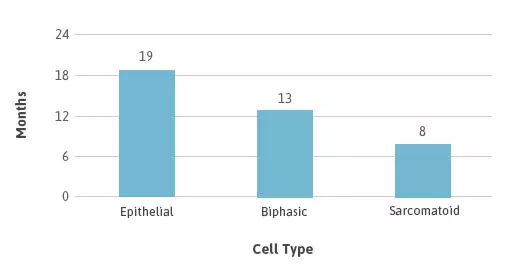

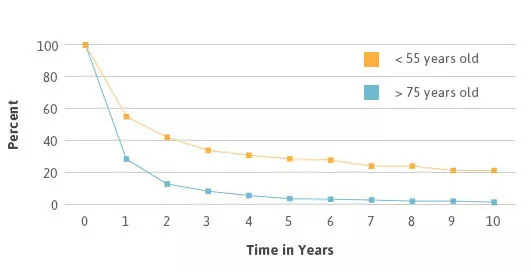
No comments
Post a Comment